
Unrivaled for architectural presence, autumn brilliance, textural elegance and grace under fire, Japanese maple trees—from diminutive 1-footers to 20-foot specimens—are headliners.
Swipe to view slides
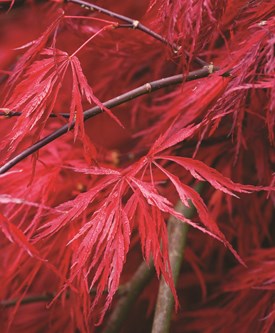
Photo by: Clive Nichols.
1. ‘CRIMSON QUEEN’
One of the most popular cultivars of Acer palmatum among gardeners, acclaimed for retaining its burgundy-red color throughout the growing season, though in the heat of the South it can sometimes go a bit green. In autumn, the ferny leaves turn bright orange-red before falling to the ground in a brilliant carpet. A mature specimen has a dramatic cascading form, making it a showpiece in the garden. Leaf tips can scorch easily, so this maple needs some shade. Can reach 8 to 10 feet tall and 12 feet wide. Zones 5 to 8.
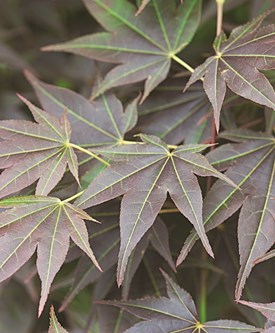
Photo by: J. Paul Moore.
2. ‘TSUKUSHIGATA’
A cultivar of Acer japonicum, this tree is known for its lustrous dark-purplish foliage that turns scarlet red in the fall. Bright-green veining adds highlights, and chartreuse seedpods twinkle among the dark leaves. A midsize maple, it grows to about 10 feet tall and almost as wide. Named for a bay on the island of Kyushu. Zones 6 to 8.
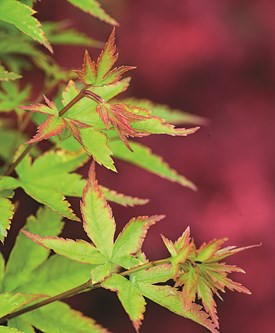
Photo by: Rob Cardillo.
3. ‘SAGARA NISHIKI’
Unfolding pink-edged in the spring, the leaves of this variegated form of A. palmatum combine pale-yellow and green markings. Fall color is reddish orange. Forms a compact small tree 6 to 9 feet tall. The foliage can be burned in bright summer sun, so make sure this cultivar is planted in light shade. Zones 6 to 8.
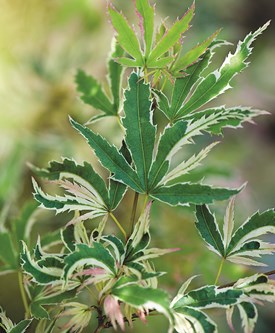
Photo by: Rob Cardillo.
4. ‘BUTTERFLY’
A variegated cultivar with leaf lobes varying in length and number, giving the tree a lively, almost frilly look. Leaves open green with cream-colored margins edged in pink. Fall shades are rose-red to red-purple. A slow grower, it eventually makes a stiffly upright, vase-shaped small tree 7 to 12 feet tall and 4 to 8 feet wide. Can scorch in full sun. Zones 5 to 8.
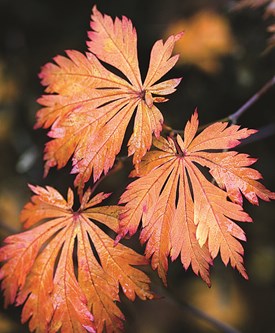
Photo by: Andrea Jones.
5. ‘ACONITIFOLIUM’
Another notable variety of A. japonicum or fullmoon maple, this one is named for having foliage reminiscent of monkshood or Aconitum, deeply divided and toothed, and almost circular in overall shape. Leaves are green in summer, transforming in autumn to orange and crimson. Has a mounded habit, 8 to 10 feet in height. Zones 5 to 7.
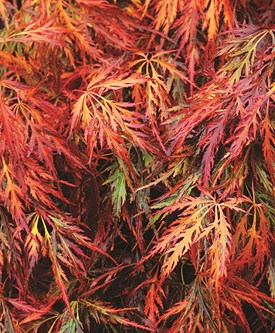
Photo by: Marianne Majerus.
6. ‘DISSECTUM ATROPURPUREUM’
This well-known variety forms a graceful, mounding scrim of lacy foliage, which drapes to the ground from an architectural armature of twisted branches. Slow growing enough to use as a dramatic specimen in a large container. Leaves are purplish red, turning fiery burnt orange in the fall. Typically reaches 8 to 12 feet tall and wide. Zones 5 to 8.
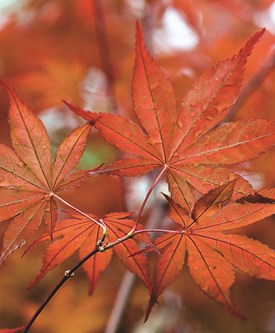
Photo by: Rob Cardillo.
7. ‘PURPLE GHOST’
A stop-in-your-tracks A. palmatum cultivar with leaves emerging maroon in spring, deepening to purple in summer, then turning tangerine and red in the fall. Adding to the show are black veining, a leathery texture and undulating leaflet edges. Touted as the most sun and wind tolerant of the Ghost series, it holds its color well through the growing season, though the brighter the light the darker the purple. The original breeder (Buchholz & Buchholz Nursery in Oregon) states that a typical size is 8 feet by 4 feet after 10 years. Zones 5 to 8.
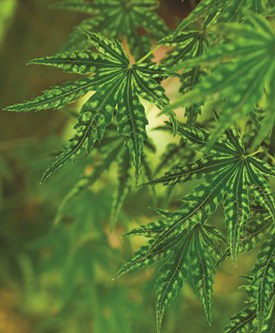
Photo by: Rob Cardillo.
8. ‘HIGASAYAMA’
A variegated form that’s been around since the 1800s, with unusual puckering along the leaflet margins, making them curl slightly. In the spring, leaf buds pop open cream and pink with an effect like flowers, changing to green with cream edges. In summer, the effect can fade to pale-green margins, giving way to bright yellow or orange in fall. A popular bonsai subject, in the garden it forms a vase-shaped tree, about 20 feet tall. Zones 5 to 8.
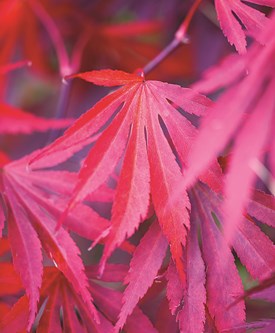
Photo by: Clive Nichols.
9. ‘BENI KAGAMI’
Meaning “red mirror,” ‘Beni kagami’ has a range of leaf color depending on the amount of shade—orange-red in high light, purplish-red with green undertones in low light. Fall brings on shades of glowing crimson. Grows to be a medium-size tree about 15 feet tall. Zones 5 to 8.
GROWING JAPANESE MAPLES
Care:
As with most plants, proper planting and attention to their needs in the early years can forestall problems later with Japanese maples, including soil amendment, mulching to keep roots insulated and supplemental watering during dry spells. Siting them in locations where they are shielded from strong winds and spring frosts will protect the foliage from unnecessary trauma. Since they typically leaf out rather early, one late cold snap can be a death knell, or at the least do enough damage to seriously alter the fine form even of a mature specimen.
Zones:
Generally Japanese maples are hardy in Zones 5 to 8, though some do better in the northerly zones and some prefer southerly climes.
Exposure:
It’s a balancing act to provide just the right amount of light—too much sun and the delicate leaf tips will fry, especially on the dissected forms; too little light and some of the colorful varieties will take on a greenish cast (though still attractive, nevertheless many gardeners are keen to see the red and purple coloring last all season). Dappled shade or high but indirect light is a safe bet. Full sun can be problematic, especially a western exposure.
Soil:
Although fairly adaptive, Japanese maples perform best in moist, well-drained, slightly acidic soils that contain organic matter. Though they are tougher than their graceful appearance might indicate and can endure periodic dry conditions once well established, it’s best to water them regularly during extreme drought situations. The key thing to remember is to avoid moisture extremes.
Need a striking focal point to give your garden punch or a backbone plant to anchor your perennial border? Maybe you have a dramatic, oversize container and are pondering the perfect plant to set it off. Or perhaps you’re a bonsai lover and are on the hunt for your next treasure. In all cases, look no further than Japanese maples. Having been in cultivation for the past 400 years—first in Japan, then later in Europe and North America—it’s no surprise that there are now hundreds of varieties, with a mind-blowing diversity of leaf shapes and colors. Some have leaflets so thin that they are mere threads, while others are almost full circles, with colors ranging from shades of green to red, purple and variegated. Primarily cultivars and forms of Acer palmatum, those of A. japonicum also qualify as Japanese maples. Some have been given such lyrical cultivar appellations as ‘Fairy Lights’, ‘Moonfire’ and ‘Baby Lace’, but many have cryptic Japanese names, the definitions of most having been lost in translation through the years. While sometimes frustrating, this also enhances the mystery and romance surrounding these highly prized plants.
Editor’s Note: This article was adapted from its original version for use on the web.
RELATED:
Japanese Maple Care
SOURCE:http://www.gardendesign.com/trees/japanese-maple.html